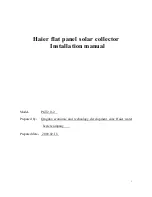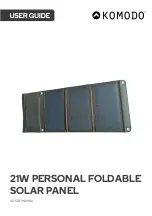
aleo
aleo solar Deutschland GmbH
| Osterstraße 15| 26122 Oldenburg | Germany | [email protected]
Page 30/60
installation instructions Edition 01/2012 en-GB-Intl (120508b)
8.
Electrical Installation
WARNING
Protect yourself against the danger of an
electric shock by wearing suitable protective
clothing and following the relevant regula-
tions.
Do not alter the connecting cables and con-
nectors of the module. Doing so avoids the
danger of an electric shock and upholds the
conditions of the manufacturer warranty.
Only use approved components and tools for
connecting a module string to the inverter.
All cabling should be done according to the
applicable regulations. Ensure that all con-
nections are in a flawless mechanical and
electrical condition.
Check that the cover of the junction box is
firmly attached.
8.1.
Order of work steps
For a safe and time-saving electrical installation process, aleo
solar recommends carrying out the work steps in the following
order:
connect the modules into strings
if applicable, parallel connect module strings
lay the cables to the inverter
install the inverter
connect the isolator to the inverter
connect the fire prevention switch to the isolator
connect the cables to the generator side
close the fire prevention switch and the isolator
8.2.
Series connection
Solar modules are usually connected in a row (series) in order
to create a module string.
String diodes are not necessary when modules are only
connected in series at a given inverter input.
8.3.
Wiring
aleo solar normally delivers its modules with firmly installed
junction boxes and flexible connection cables with pre-
installed connectors and sockets.
NOTICE
Avoid tensile as well as pressure loads on the
junction box during installation.
This may cause damage to the cable entry
points and affect the service life.
Also avoid excessive tensile loads to the pre-
assembled plug connections during installation.
In plug connections without locks this can lead
to loosening or detachment of the plug
connections.
In plug connections with locks this can, in
extreme cases, lead to loosening or detach-
ment of the crimp.
This can cause increased transition resistance,
heat build-up, and fire hazards.
Observe the laying regulations for the respective cable types.
Lay all cables in such a way that:
you comply with the minimum bending radii (e.g.
the 15-fold cable diameter)
close proximity to sharp corners and edges is
avoided, or the cables are correspondingly
protected
cables with differing voltages, such as the positive
⊕
and the negative
⊖
connection of a module
string do not rub against one another
module string cables have a sufficient distance
from earth, potential equalisation, and lightning
conductors
all cables run as close to one another as possible in
order to minimise the inductive area and, accor-
dingly, the effects of a lightning strike or stray
current (see also Ch. 5.12.2, 'Wiring and lightning
protection').
Carefully lay the wiring to protect the laid cables from
damages caused by:
direct environmental influences, such as
precipitation
movements through direct environmental
influences, such as wind
indirect environmental influences, such as snow or
ice that can slip behind the modules.
G
ID A
S
033
c









































